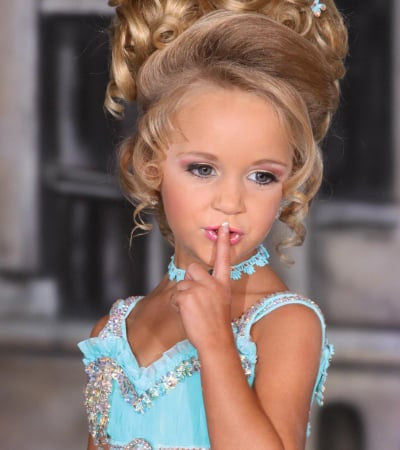Puttin' On The Glitz
The life of a toddler in a tiara can be Quite different from what you see on reality TV

One simply has to search for “glitz pageants” on YouTube to be confronted with video after video of preschoolers in costumes; they’re singing, dancing, twirling — and even lasso-ing — their little hearts out, made up, costumed, high-heeled and wigged. You might find some clips from “Toddlers & Tiaras,” featuring wild-eyed “pageant moms” obsessing over clip-on teeth or babies crying during spray tans.
“Those shows represent about 2 percent of the reality of pageant life,” says 24-year-old Victoria Ratliff Harris, Miss Florida Teen USA 2005 and the founder of Victoria & Company, a Jasper-based business with services ranging from fitness to pageant coaching. “They catch parents at their absolute worst moments and then sensationalize that. Who hasn’t been stressed out when their child is competing?”
She has a point. But the thriving pageant subculture is difficult for those outside its circle to understand — perhaps in the way it’s difficult for non-fans to understand professional wrestling or Pokemon. Pageant enthusiasts have their own jargon, uniforms, competition season and favorite competitors. They hire coaches, train, travel to compete and, in some cases, earn thousands of dollars. And some of them do all this before the age of two.
Glitz vs. Natural
“I competed in my first pageant when I was nine months old,” said Harris. “Of course I don’t remember it.” Her mother began entering her in pageants, said the small-town girl, because she wanted her daughter to have more opportunities. A singer and dancer, Harris said she enjoyed every minute of the glitz pageants, where she got to showcase her talents and gain confidence in front of an audience.
“Glitz” refers to the kind of pageants you see on “Toddlers & Tiaras”; in fact, Harris said she competed in many of the same pageants featured on the TV show when she was a child. The National Gold Coast Pageant is the real competition featured in the movie “Little Miss Sunshine,” while Universal Royalty, another major circuit pageant, proudly advertises its association with “Toddlers and Tiaras” reality show on its website.
Encouraging makeup and glamorous clothing, glitz pageants generally judge their young competitors — some of whom are barely walking — in categories from swimsuit to talent. Contestants may appear with clip-on teeth, fake hair, false eyelashes and elaborate costumes bedecked with plenty of “bling.”
Hundreds or even thousands of dollars in prize money may be up for grabs, but the upfront investment can be so steep that few pageant competitors actually expect to come out in the black. Pageant entry fees can run from $100 to more than $1,000 for participation in all categories offered for competition — and that’s just the fees to enter.
“It is a very costly process,” said Dr. Debra Maddox, a pageant producer whose granddaughters are regular competitors. Maddox also owns Miss Florida Capital City, Inc., a nonprofit pageant system supporting Breast Cancer Awareness.
Maddox went on to explain: “Pageant coaching can cost from $75 to $200 an hour, plus expenses of the coach traveling, if one is not locatedin your area, which Tallahassee does not have. Dresses for glitz pageants can cost from $500 to $3,000.” Altogether, she said, it’s easy to spend $8,000 to $10,000 to get one girl ready for a glitz pageant, depending upon the scope of the competition categories.
“It really costs what you want to put into it,” explained Harris. “But that’s the same with any hobby. Look at baseball: You can spend $300 to $500 on a baseball bat for a serious player.”
“Natural” pageants, in contrast to glitz, generally ban makeup on girls under the age of 13. While there may be a talent portion to the competition, competitors will win no points from judges for dressing as a prostitute (an actual costume from an episode of T&T) and will lose no points for the occasional age-appropriate missing tooth.
Some natural pageants have cash prizes and most, such as America’s Junior Miss, have some academic or social outreach component for which girls can earn recognition or even scholarships. Many emphasize mentorship, such as the Miss America Organization’s Princess Camp.
A Crowning Achievement
Harris said she competed in glitz pageants from the age of 7, but didn’t win a single title until she was 14 years old. “I didn’t know what I was missing!” she said, and explained that she had fun even when she didn’t bring home a crown.
She also pointed out that her parents never forced her to compete in pageants: “If I wanted to compete, they wanted me to. But I didn’t have to.” Her older sister, who also started out in pageants, chose to stop competing, Victoria explained, when she was teased about it by friends at school.
Harris continued to compete, but while she came close a couple of times, she never won. Then her dad made a bet with her, she said. “He used to dip tobacco, and he said, ‘If you win Grand Supreme, I’ll quit.’”
Harris did, in fact, take the crown and top honors at her next pageant. “But he said because it was just based on facial beauty and no modeling; it didn’t count.” She had to win Grand Supreme at two more pageants before her dad finally threw in the towel and gave up tobacco for good. She won the titles in such pageants as Cover Miss, Fabulous Faces and Glamour Dolls.
 Photo by Scott Holstein
Photo by Scott Holstein
And by that point, Harris had a taste for winning. In 2005, she was crowned Miss Florida Teen USA, a preliminary to the live, televised Miss Teen USA pageant.
Now Harris coaches girls as young as 18 months old to compete in pageants in the glitz circuit, as well as mentoring girls of all ages on wellness. There is one important factor, she said, that helps girls — and their parents — learn how to compete in pageants and keep a healthy perspective about themselves and their hobby.
“You can’t make ‘winning a pageant’ a goal, because you can’t control that,” she explained. “You have to relinquish that desire for control.” She tries to make sure her tiny clients understand that they can only control their own actions and performance, not how other people perceive them — an important lesson for any child to learn.
She also thinks it’s important for them to learn how to take constructive criticism. “Getting score sheets back that say things like, ‘Smile more,’ or ‘Have better eye contact,’ teaches them how to do better next time.”
Beauty From the Inside Out?
“Good sportsmanship and positive self-esteem are two great benefits [of pageants],” said Maddox. “If the parent or grandparent instills these skills of good sportsmanship behavior in their children or grandchildren, it is much like a sport.” And it must be said that while “Toddlers & Tiaras” makes sport of crazy pageant moms, one doesn’t have to spend too long on the sidelines of a Little League game to find a few obsessive parents.
“I’ve only seen Madysen get upset, when Savanna won and she didn’t, at one pageant,” said Maddox. “She showed signs of jealousy over the prize Savanna won, not the crown — the prize was a Barbie doll!”
It’s also easy for an outside observer to point to examples like the toddler dressed in the “Pretty Woman” costume and question the role of pageants in objectifying young women, even children. But according to Maddox, a pageant “is not — or should not be — a contest of who is the most beautiful. A pageant system should strive to project their pageant image as one that sees the ‘total package.’” She points to the benefits her granddaughters — ages 2, 4 and 6 — have gained in learning to walk, speak and perform on stage in front of a crowd.
Tallahassee mom Sarah Smith* has a different perspective. Her 14-year-old daughter, Katie,* started competing in pageants when she was 2 years old and continued competing until last year. “She used to watch all the big pageants on TV,” said Sarah. “She wanted to be Miss America.” Last year, Katie was hospitalized twice because of anorexia.
“I’m not saying beauty pageants gave her an eating disorder,” explained Sarah. “I know it’s not that simple. But I don’t think it helped.”
Smith said she first entered Katie into pageants just for fun, but as Katie started to win, “we all got caught up in it.” She said she spent more than $10,000 one year in travel expenses alone to take Katie to obscure out-of-state pageants. “When she was about 7 or 8, we stopped doing that, because we couldn’t afford it any more.”
By the time Katie was about 10 years old, Smith said, she was a “little chubby” and some people, even some family members, teased her about it. The constant focus on “being skinny” drove her daughter into a downward spiral, Smith said. “If she didn’t do well at a pageant, she was convinced she was fat. If anything bad happened to her, she thought it was because she was fat.”
Former Miss Florida Allison Kreiger (2006) understands Katie’s struggle. For years, Allison battled an eating disorder, an illness which she describes as a “silent killer.” No one in her close-knit family knew that she was struggling until the end of her junior year of high school, when she finally started treatment. Kreiger had been a competitive baton twirler for 18 years and said it was her competitive nature and desire for control that drove her eating disorder — not a desire to be skinny.
“I had always looked up to the [pageant] titleholders in our community as role models,” said Kreiger. “For me, competing in pageants represented a goal, because I had to get healthy enough to compete.” Naturally, her closest friends and family were concerned the pressure of pageant competition would cause her to relapse and her eating disorder to resurface.
In fact, she said, she found her voice through pageants. “My crown became my microphone,” she explained. “I was able to mentor not only my peer group but young women involved in pageants. I was able to encourage them and advise them against yo-yo dieting or crash dieting before pageants. I realized I wanted to find a way to mentor young women about living a healthy lifestyle.”
Out of this experience, HOPE was born. Helping Other People Eat, Inc., is the charitable organization Kreiger started to focus on prevention and awareness of eating disorders. As a result of her passionate work, she was not only crowned Miss Florida in 2006, but also received the Miss Florida Community Service Award and the Miss America State Community Service Award. Now, in addition to finishing her last semester of law school, she travels the country as a motivational speaker and advocate for people with eating disorders. She will also give birth to her first child, a daughter, in February.
“I probably won’t encourage my daughter to compete in glitz pageants,” she confessed. “But I will absolutely encourage her to participate in organizations like the Sunshine Princess program, which is founded on mentorship.”
But Kreiger was quick to point out that she has mentored many young women who spent many happy years in glitz pageants when they were younger. “It was their hobby and they loved it,” she said. “For many of them, it helped them refine skills they already had, skills that they have strengthened and used throughout their lives.”
Do Pageants Still Have Legs?
Pageants have survived and evolved, despite the fact that many have predicted their extinction. Nielsen ratings show a steady decline in viewership of traditional televised pageants, like Miss Universe and Miss America, since the 1970s. That being said, reality programs like “Toddlers & Tiaras” have breathed new life into the glitz pageant circuit. And the Internet has given rise to online photo contests and new marketing avenues for smaller pageants.
“I feel the pageant industry is definitely growing,” said Maddox. “I see pageants springing up all over Florida and other areas and systems being created for great causes. I think they can also be great local fundraisers if they partner with organizations and civic functions.”
Maddox’s granddaughters currently compete in one or more pageants a month and love every minute of it, she said. “[Two-year-old] Ashtyn has only been in one pageant but she is already showing very strong signs of being very stage-worthy having watched her sisters become successful,” she said. “She was in the Miss Snowflake Queen pageant last year in March and came in first runner-up and best dressed.” The older girls, Madysen and Savannah, have about 20 crowns between them, including the 2011 Tiny Miss Snowflake Queen and the 2011 Wee Miss Black Eyed Peas.
Miss Capital City, Maddox’s local pageant for girls from 1 month to 24 years old, will take place on February 25 at Tallahassee Community College. The pageant will have a “Pretty in Pink” theme to emphasize breast cancer awareness.
Katie Smith won’t be competing in that pageant, or any others, this year. She is in a private treatment facility for her eating disorder and is getting healthier every day, her mom said. She will return to high school soon. “She’s smiling a lot more and starting to talk about college,” explained Sarah. “But even after everything we’ve been through, she still says she wants to be Miss Universe one day.”
*Names have been changed to protect minors mentioned.


